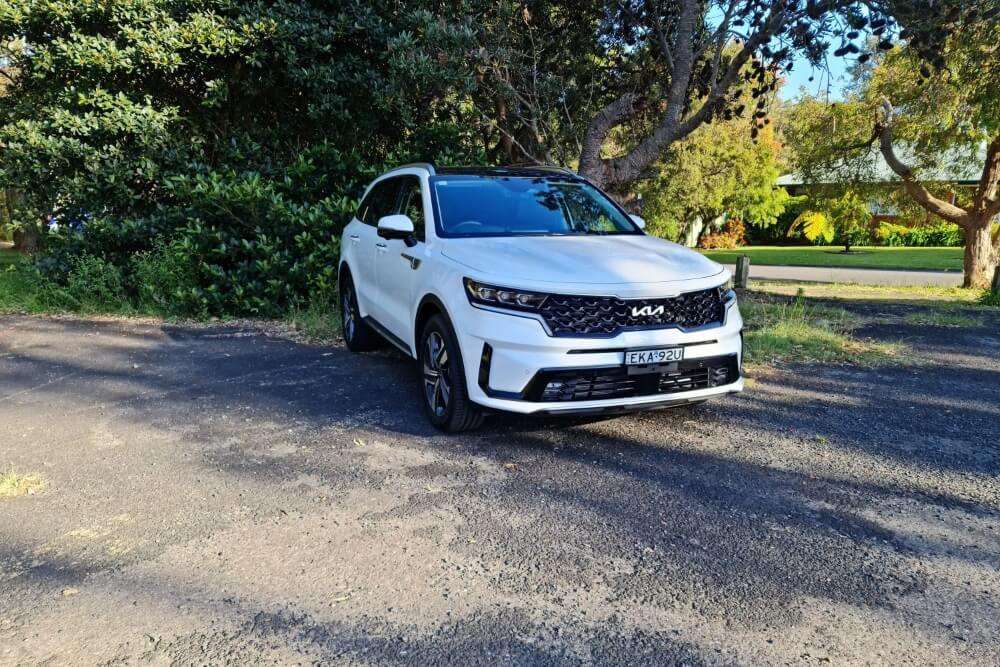
2022 Kia Sorento GT-Line Plug-in Hybrid And V6 Petrol Review
It would be easy to sum up the differences between the two as horses for courses, or a similar analogy, but it’s not that simple. We were blown away by the capabilities of one variant, to the point where a friend of the team has gone and bought one on our advice.
One outstanding specification. Two very different powertrains. We pit the 2022 Kia Sorento GT-Line Plug-in Hybrid against one of its own, in the form of the V6 petrol version of the same SUV, at the same trim level.
We’ll tell you which version that is shortly, but first, let’s break down what’s on offer in the Sorento GT-Line and individually in the PHEV and petrol variants, and just how we tested them out to see which one came out on top.
Read About The 10 Best PHEVs In Australia
To describe our time testing these two vehicles as being at the height of COVID chaos is an understatement. Omicron was running riot across NSW, and indeed Australia, and yet, with the right precautions, we were able to hit the road for some actual road trips.
In the case of the PHEV version of the Sorento, we went north, engaging in a number of shorter road trips that were no more than two to three hours in duration, but gave us the opportunity to put it to the test in a variety of circumstances and driving conditions.
Conversely, the petrol variant went long, in what was a good comparison of the scales of fuel economy, with tonnes of highway driving. We ventured south, to the country town of Goulburn, and then onto the sleepy hollow that is Crookwell.
Check Out Our Review Of Another PHEV, The Mitsubishi Eclipse Cross Exceed
Powertrains
The Kia Sorento comes in four specifications, in the form of the S, Sport, Sport+ and GT-Line. There are three powertrain options; a 2.2-litre diesel (not tested here), a 3.5-litre petrol V6, and the new kid on the block, the plug-in hybrid.
It’s powered by a 1.6-litre turbocharged petrol engine, paired to a lithium-ion battery powered electric motor. The PHEV is only available as a GT-Line, and that’s good, because the range topping spec is a really well put together package, with all the goodies thrown in.
But first, let’s talk numbers. The 3.5-litre V6 petrol model is front-wheel drive only. It delivers 200kW of power and 332Nm of torque through an 8-speed auto transmission. It rides on 20-inch alloy wheels. It has a 2,000kg braked towing capacity.
It also offers a claimed fuel economy of 9.7-litres/100km. We managed 8.4-litres – consistently, on our long haul drives to Goulburn, which we have to say is fairly impressive for the naturally aspirated Sorento 7-seater. In traffic, it sat around 10.4-litres/100km.
The hybrid is all-wheel drive and offers a combined 195kW of power and 350Nm of torque from its dual powerplant combination, which is paired to a 6-speed automatic gearbox. It rides on 19-inch wheels (and no, we don’t know why they’re different).
It has a braked towing capacity of 1,350kg (with a 100kg ball weight instead of 200kg like the petrol and diesel variants), and a claimed fuel economy of 1.6-litres/100km. Good luck ever actually achieving that. Reality is a still super impressive 3.9-litres/100km.
It has an AC (that’s plugged into the power point) charge time of 3 hours and 25 minutes to 95 per cent charged – that’s pretty on the money. It has a claimed battery only range of 68km (again, good luck) – which is more like 51km in reality.
Both variants have the same 67-litre fuel tank. Here’s the thing though. We started both seven day testing periods with a full tank. We did roughly the same amount of kilometres in travel for both test periods (give or take 50km). We never refilled the PHEV.
That says buckets about the capability of the PHEV, particularly in terms of fuel economy, but more on that later.
Kia Ranked #2 Car Brand In Australia, View The 2022 Sales Figures
Storage
First, let’s talk about luggage space, because thanks to the fact the batteries are under the second row seats, the two vehicles are different.
In the petrol variant, you get 187-litres with all seven seats up (175 in the PHEV), 616 with just the second row up (604 in the hybrid), and 2,011-litres, with all seats laid flat (1,988 for the eco-friendly offering).
On the road
Drive modes are different too, with the 2WD petrol variant offering Comfort, Eco, Sport and Smart, with the first of these missing from the hybrid. That said, both versions drive exceptionally well, with super impressive ride and comfort. Handling is near perfect.
The petrol V6 is quite noisy on the road, thanks in part to its bigger wheels and the fact it’s quite hard revving. The gearbox shifts seamlessly when upshifting, but does seem like it’s working hard on the downshift.
Exterior design
Externally, it’s a good looking rig, in either form, and the GT-Line comes with LED daytime running lights and dusk sensing automatic front headlights, high beam assist, and LED front and rear fog lights.
Roof rails are standard, as is a rear roof spoiler, powered panoramic sunroof and hands-free smart power tailgate. Auto rain sensing wipers front and rear also feature.
Interior look and feel
Inside, there’s keyless entry and remote start, quilted Nappa leather appointed seats, with 14-way power adjustment for the driver’s seat, with integrated memory, and a 10-way power front passenger’s seat.
Second row seating in the 7-seater is sliding and reclining, as well as having one touch flat folding capability. There’s an absolute stack of leg and head room, and even the split fold third row seating has reasonable kid to teen friendly room.
There’s a 12.3-inch colour TFT LCD instrument cluster, a colour head-up display, 64-colour ambient lighting, alloy door scuff panels and similar sports pedals, two 12v power outlets, three front USB charging ports, with two in the second row, and two in the third.
Wireless phone fast charging completes the incredible specification list inside.
Safety
From a safety perspective, it grabs ABS, stability control, trailer assist, hill start assist and downhill brake control, multi-collision braking, and front and rear parking sensors with dash display.
Blind spot detection, and lane keep and lane change assist make use of video streams from the camera in the mirrors to assist you on the road, displaying the result in the digital instrument cluster (which is definitely one of the coolest features on the car).
There’s also a 360-view camera, rear cross traffic collision avoidance, autonomous emergency braking, forward collision warning with car, pedestrian, cyclist and junction, parking collision avoidance and driver attention alert.
Pricing
The 2022 Kia Sorento GT-Line in petrol V6 form costs $64,290 drive away. The plug-in hybrid is priced at $81,990 drive away. Both had premium paint in Steel Grey and Snow White Pearl respectively.
The final verdict
The wash up of all the differences between the two variants, the petrol V6 2WD and the plug-in hybrid AWD is this; if you need to tow anything decent, but aren’t headed off road on a regular basis, buy the petrol variant. If you are keen to get dirty, the diesel is AWD.
If you’re never going to tow anything like a caravan, or even a camper trailer, and you wouldn’t mind ducking off on the dirt for a camping trip with the kids, in the tent you put in the boot, and you love saving money and being economical, buy the PHEV.
The latter costs significantly more than its petrol counterpart. There’s no denying that. But the savings you make over the 5-7 years, or longer, you’ll own the Sorento (assuming you’ve a family and normal budget constraints), mean it’s worth it.
Our test vehicles were supplied by Kia Australia. To find out more about the 2022 Kia Sorento GT-Line Petrol V6 and Plug-in Hybrid, contact your local Kia dealer. To read the full story, visit Exhaust Notes Australia.
Finance A New Or Used Kia Sorento Through Credit One - Get A Free Quote




